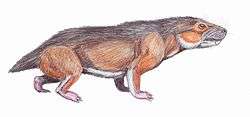Eutheriodontia
| Eutheriodontia Temporal range: Middle Permian-Holocene, 265–0 Ma | |
|---|---|
 | |
| Life restoration of the therocephalian Sesamodon browni | |
 | |
| Life restoration of the cynodont Tritylodon longaevus | |
| Scientific classification | |
| Kingdom: | Animalia |
| Phylum: | Chordata |
| Order: | Therapsida |
| Clade: | Theriodontia |
| Clade: | Eutheriodontia Hopson & Barghusen, |
| Groups | |
Eutheriodontia is a clade of therapsids that includes therocephalians and cynodonts. The clade was erected in 1986, and a close relationship between therocephalians and cynodonts has been recognized for many years. Therocephalians and cynodonts are thought to have diverged in the Middle Permian, and each group independently evolved mammal-like features, including a secondary palate and the loss of a postorbital bar (these features were retained in mammals, which are considered a derived group of cynodonts). Mammalian features that both groups inherited from a common ancestor include the loss of teeth on the palate, the expansion of the epipterygoid bone at the base of the skull (an area called the alisphenoid in mammals), and the narrowing of the skull roof to a narrow sagittal crest running between large temporal openings.[1]
References
- ↑ Rubidge, B.S.; Sidor, C.A. (2001). "Evolutionary patterns among Permo-Triassic therapsids" (PDF). Annual Review of Ecology, Evolution, and Systematics. 32: 449–480. doi:10.1146/annurev.ecolsys.32.081501.114113.